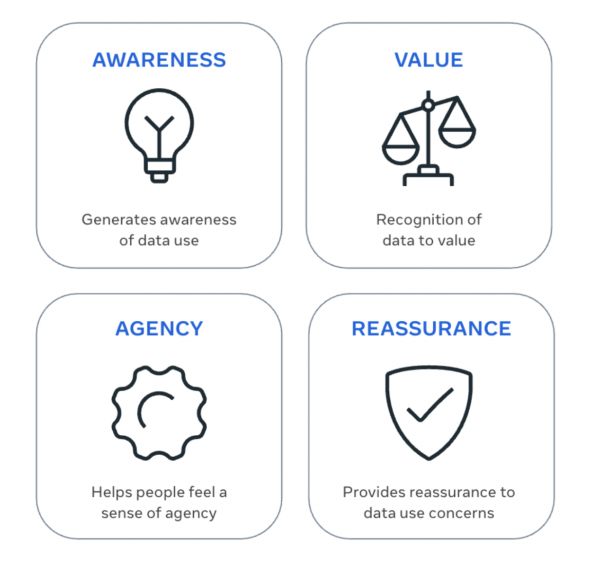Publication date: 21 October, 2025
Author’s note: Product teams at Meta rely on research along with other factors to design and build products. This article discusses research conducted by Meta's Research Team to better understand consumers’ expectations and experiences with AI personalization.
Abstract
To build valuable AI assistants, we’ve conducted user research to understand people’s desires and expectations, and how personalization impacts users’ experiences with these products. This article synthesizes key insights from several studies about user sentiment toward personalized AI assistants.
Overall, some participants consistently expressed that they value when AI assistants are personalized because it can help them better achieve many of their goals for using an AI assistant in the first place. At the same time, participants sometimes encountered moments of hesitation when they felt tension between personalization and privacy.
We also identified key qualities of transparency and control that companies can leverage to help people better understand and manage data use for personalized AI in some cases.
Introduction
Personalization offers the promise of enhancing user experiences with AI assistants by tailoring interactions to individual needs. To inform product teams building these experiences, researchers at Meta have conducted studies with users of AI products. We synthesized sixteen studies (both qualitative and quantitative in nature) focused on AI conducted by Meta researchers between 2024-2025; all included research participants in the US, and several also included additional markets in Europe, Africa, Latin America, and Asia. We found three core themes: 1) Participants often believed that AI assistants that were personalized could better help them achieve their goals, 2) In certain moments (described below), participants sometimes expressed tension between the value of personalized AI and privacy, and 3) Some participants believed transparency and control about data use could help them feel more confident and comfortable in some cases. Below, we dive deeper into these findings and opportunities for product teams.
Key Insights
1. Personalized AI Assistants can help people achieve their goals
Some participants across studies expressed that when AI assistants were personalized, they thought it could significantly aid in achieving their personal goals for using AI products (e.g., answer seeking, advice, inspiration, entertainment). Participants especially appreciated being able to offload tasks that feel mundane and repetitive to an AI assistant (e.g., writing emails, coordinating calendars, shopping) to free up time and energy for things they enjoy. There are three core reasons that participants indicate for why personalization enhances the value of AI assistants:
- Relevance: Specifically, participants consistently shared that when the AI remembers key information about their interests and preferences, it can create information, recommendations, and support that are more relevant to them. For example, one participant shared that the assistant would feel like a real local if it mentioned specific places and hotspots in their city.
At the same time, when personalization was felt to be lacking from AI assistants – for example when the AI assistant didn’t ask a follow-up question to get to know preferences or needs better, or when it didn’t remember past conversations – some participants cited missed expectations. For example, another participant said that after telling the assistant many times how they wanted responses modified and formatted (e.g., shorter, using bullets, more conversational tone), they'd expect it to just remember those preferences for future responses.
- Speed: Participants shared that when an AI assistant remembers past conversations, it can help them achieve their goals faster and more efficiently. One participant specifically expressed that by saving certain details, they would not need to start from scratch every time. Other participants shared that if an AI remembered their writing style and tone, it could speed up writing tasks. Or if it knew their food preferences and restrictions, it could make proactive suggestions by anticipating their needs or overall make meal prep go faster.
- Engagement: Some participants felt that personalization not only provided more immediate and relevant responses, but the whole experience felt more engaging. Participants expressed the notion that having a personalized interaction made them feel less generic and more catered to.
2. Tension Between Personalization and Privacy
While personalization can be valued, it can also raise concerns — including about accuracy of responses, overreach, and privacy. While privacy concerns were not always top of mind, some participants encountered moments of hesitation (where some latent concerns are brought to the forefront) – creating a feeling of tension between personalization and privacy. Some moments of hesitation we have heard about across studies include:
Upfront in the user journey:
- Trying a new feature for the first time (onboarding),
- Want to know information about the purpose of data collection or use
In the context of using the product:
- Want to know information about the underlying information in a personalized experience,
- Unsure how to manage data sharing,
- Unsure if they could be sharing other people’s data,
- Want reassurance that data will be protected,
- Want reassurance that information will not be exposed to unwanted audiences.
In these moments of hesitation, research participants expressed questions like: “How do you know this?,” “How will this data be used?,” “Who has access to this data?,” and “How can I manage data used?” – suggesting transparency and control might have the potential to ease some concerns.
3. Qualities of Transparency & Control
Time and again, user studies suggest that providing information about data use and offering control mechanisms can build confidence and comfort in using AI technologies. Studies focused on how to deliver transparency and control in a user-centric way suggest four overarching goals designers might strive for to meet user goals:
A. Awareness: Transparency can help by generating awareness of data use - i.e., minimizing the potential for users to be surprised that information is used to personalize their AI experiences.
Across several studies, when participants understood AI was using what it knows about them to personalize its response, it signaled to some that AI was building an understanding of the user to provide a better experience and helped them feel more comfortable with data use.
B. Value: Transparency can help by stating the benefits of the data use for users.
Across several studies, participants viewed certain data use cases more favorably when the provided transparency or experience helped them make the connection between the data use and their broader goals and motivations for using the product.
C. Reassurance: Transparency can be reassuring when it is easy to find and addresses top of mind concerns in key moments of hesitation.
For example, participants sometimes want reassurance to know that their information won’t be seen or accessed by unwanted audiences.
D. Agency: Transparency and controls can help users to know how to find and exercise choice over how they engage with products and manage information used about them.
Controls can be of varying types. We heard feedback that participants liked being asked to share specific information for relevant responses. Some participants preferred granular controls for certain bits of personal information. Specifically for MetaAI, some participants’ who expressed a desire for it to remember information about them also had underlying expectations of being able to edit or tweak that information.

In addition, some participants providing feedback on transparency concepts options say they prefer when information about data use is succinct, easy to understand, and provides opportunities to dive deeper if desired. Participants expressed appreciation for upfront information when they start to use products, but also respond favorably to concepts that provide transparency during the interaction or use of the products – i.e., contextual information and options if and when they experience moments of hesitation.
Opportunities for Design and Product
Based on this body of research, we see opportunities for transparency and control over data use for AI personalization:
- Transparency along the user journey: Providing direct, succinct, straightforward, and contextually relevant information about data practices in key moments as users’ interact with AIs can support confidence with personalization AI.
- Empowering users with control: Offering easy-to-find educational resources and options to provide direct signal on relevant data use may empower users to manage their data effectively, fostering a sense of agency and reassurance.
- Conversational transparency and control: As AI technologies increasingly offer personalized experiences, companies may need to design new ways to effectively deliver transparency and control through natural text and voice back-and-forth conversation. Design patterns that work in text modalities (e.g., emphasis on headlines) may not translate one-to-one for voice interactions.
At the same time, it’s important to recognize that where, when, and how to build transparency and control features requires Product Designers to weigh multiple factors and user-interface constraints (e.g., content length, progressive disclosure, etc). The insights above provide directional guidance that designers may use as they strike the right balance on amount of information, placement, and design patterns.
Conclusion
AI personalization holds great potential to provide valuable experiences to users. Delivering personalization with transparency and control has the potential to help people feel confident in using these personalized AI experiences. We encourage continued research with end-users to guide building experiences that deliver on the user goals uncovered here.
Overall, we found that user participants in research about AI personalization often believed that AI assistants that were personalized could better help them achieve their goals, and expressed that transparency and control about data use could help them feel more confident and comfortable with these experiences.
